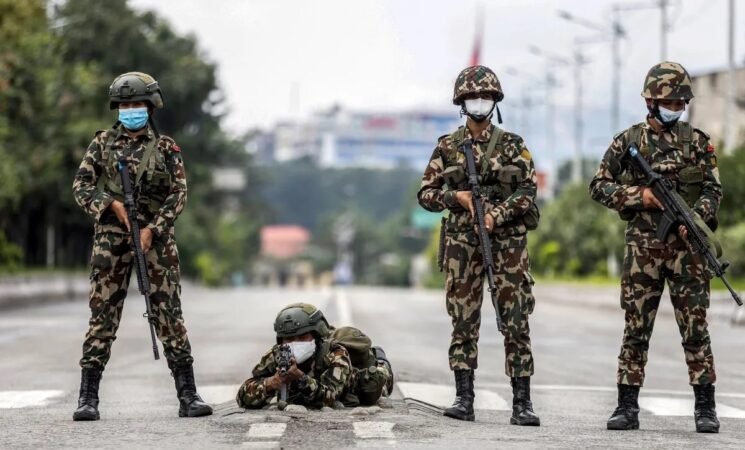31 October 2025, NIICE Commentary 11883
Sumitra Karki
When flames engulfed Singha Durbar, the Parliament Building, the President’s Office, and the Supreme Court during the recent Gen Z–led protests, one question echoed across the nation: Where was the Nepal Army? As mobs torched symbols of the state, security forces appeared paralysed. For a country that prides itself on having one of South Asia’s most disciplined and battle-hardened militaries, the Army’s apparent absence from the front line was both conspicuous and unsettling. Yet beneath that silence lay a deliberate calculation—rooted in legality, legitimacy, and the fear of pushing a fragile republic toward civil war or even foreign intervention.
A State on the Brink
The protests, triggered by the government’s abrupt decision to ban major social media platforms, quickly escalated into a nationwide revolt. What began as digital outrage among young Nepalis transformed into an anti-establishment movement fuelled by anger over corruption, unemployment, and elite arrogance. Within days, the police were overwhelmed. Government offices were torched, curfews ignored, and parts of Kathmandu descended into near-anarchy.
As the situation deteriorated, public calls mounted for the Nepal Army to intervene. The Constitution authorises the deployment of the Army under the National Security Council’s advice when “a grave emergency threatens sovereignty, territorial integrity, or national unity.” By any measure, the protests met those criteria. Yet, even as smoke rose over the capital, the Army maintained a defensive posture—protecting strategic installations and key leaders but avoiding direct confrontation with protesters.
Legal Lines and Political Caution
The Army’s first constraint was constitutional and political. Nepal’s post-2006 democratic order was founded on a fragile balance between civilian supremacy and military professionalism. The memory of past conflicts—especially the Maoist insurgency—still shapes the institution’s caution. Any domestic deployment without full civilian consensus risked reviving old accusations of authoritarianism or even coup-like behaviour.
Senior commanders reportedly refused to act without a formal order endorsed by both the President and the Cabinet. Yet, amid resignations, political paralysis, and the caretaker nature of the government, such authorization was almost impossible. The Army thus faced a legal and moral dilemma: act decisively and risk being branded interventionist, or hold back and watch state institutions burn. It chose restraint.
Fear of Escalation
The decision to refrain from large-scale deployment was not simply legal—it was strategic. Unlike the police, the Nepal Army carries immense symbolic and psychological weight. Its mobilisation signals the transition from a political crisis to a state of emergency. In a nation scarred by a decade-long insurgency, the sight of soldiers confronting unarmed but enraged youth—many waving national flags and singing patriotic songs—could have turned civil unrest into civil conflict.
Commanders reportedly assessed that even a single miscalculated confrontation resulting in civilian casualties could have delegitimised the Army—the last institution still broadly trusted by the public. Moreover, if soldiers had suffered casualties during efforts to control the protests, the emotional backlash could have escalated tensions further, risking open confrontation between the state and its citizens.
The leadership also drew lessons from the region. In Pakistan, Bangladesh, and Myanmar, militaries that intervened in domestic unrest ended up eroding their legitimacy and deepening political divisions. Nepal’s generals were acutely aware that the use of force against its own youth could undo decades of hard-won trust and reopen the wounds of the post-conflict transition.
Thus, restraint was an act of prudence. It aimed not only to prevent bloodshed but also to preserve the Army’s institutional credibility as a national rather than partisan force. The leadership calculated that maintaining internal cohesion and public trust would serve the republic better than short-term displays of strength.
The Army’s restraint was also influenced by external considerations. As one of the largest contributors to UN peacekeeping missions, the Nepal Army enjoys strong international respect for its commitment to human rights. Any excessive use of force resulting in mass violations could have jeopardised its global reputation and risked the suspension of military cooperation and aid from the United States and other Western partners. This international dimension likely featured in the Army’s strategic calculus.
The Foreign-Intervention Factor
Another, more discreet, consideration was geopolitical. Nepal’s position between India and China makes any internal instability a potential regional concern. Both powers have deep strategic interests in Nepal, viewing its stability through the prism of their own security. Beijing remains hypersensitive to instability that could spill into Tibet, while New Delhi views chaos in Kathmandu as a threat to its traditional sphere of influence.
Had the protests spiralled into uncontrollable violence, the risk of foreign intervention—covert or overt—would have become real. A scenario in which the Nepal Army failed to contain a domestic conflict could have opened the door for external “stabilisation” efforts under the guise of humanitarian assistance or peacekeeping. For a small, landlocked state navigating its sovereignty between two giants, such an outcome would have been humiliating.
Security analysts suggest that the Army’s top brass considered the worst-case scenario: if the unrest had evolved into civil war and the government collapsed, Nepal might have had to invite external assistance—perhaps from the Indian Army or even under a UN peacekeeping mandate. Either option would have undermined the Nepal Army’s prestige and Nepal’s sovereign claim to self-management.
In this context, the Army’s restraint was not passivity but a form of strategic defence—preventing conditions that could justify foreign intrusion. By avoiding escalation and preserving internal order through minimal engagement, the Army effectively shielded Nepal’s sovereignty from becoming a pawn in regional geopolitics. Maintaining discipline, neutrality, and the perception of control was, in itself, a geopolitical act.
Tactical Limitations and Public Optics
Critics argue that this calculated restraint verged on paralysis. The Army, with its intelligence networks and logistical strength, could arguably have protected key state assets more effectively. Its defenders counter that the protests were leaderless, decentralised, and highly adaptive—making traditional command-based responses ineffective.
Unlike in natural disasters, where the Army’s role is unambiguous, domestic unrest demands political legitimacy. Without a clear mandate and defined rules of engagement, military intervention could easily have resulted in tragedy rather than order. In that sense, the Army’s non-engagement was not weakness but a recognition of constitutional boundaries.
Nevertheless, public perception was bruised. To many, the Army appeared distant—guarding elites rather than the republic. In an era of heightened youth mobilisation and digital activism, silence can be misread as indifference. The challenge now lies in transparent communication: The Army must explain that its restraint was guided by national interest, not apathy, if it is to retain public trust.
Strength in Restraint
In retrospect, the Army’s decision to hold back may have averted a greater catastrophe. The government eventually collapsed under political pressure, not military coercion. Order was restored through joint police–military curfew, and Nepal avoided the nightmare of soldiers shooting citizens in the streets—a scene that could have fractured the institution and reignited dormant insurgent networks. The Nepal Army’s conduct during the Gen Z protests should therefore be judged not by the buildings it saved, but by the conflict it prevented. Its restraint reflected a disciplined understanding of both domestic fragility and regional sensitivities. But restraint has limits. Unless Nepal’s civilian institutions regain public legitimacy, even the most professional army cannot indefinitely shield the state from its own failures.
Sumitra Karki is the Director at the Nepal Institute for International Cooperation and Engagement (NIICE).

